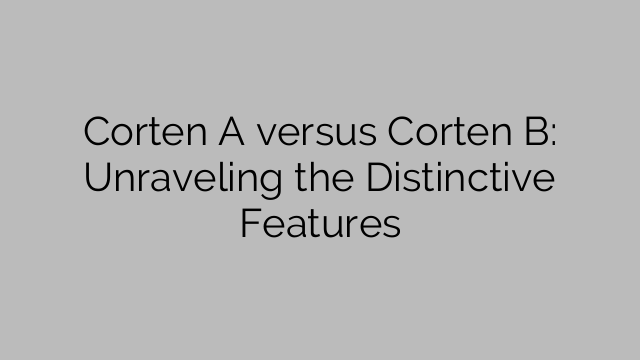When it comes to weathering steel, Corten is a name that immediately comes to mind. Renowned for its distinctive rust-like appearance and ability to withstand harsh outdoor conditions, Corten steel has become an iconic choice for architects, designers, and artists alike. But did you know that there are different variations within the Corten family? Corten A and Corten B are two grades of weathering steel that offer their unique set of characteristics and benefits. Let’s unravel the distinctive features of each and understand their differences.
構成:
Corten A and Corten B are both low alloy steels, primarily made up of iron, but with the addition of chromium, copper, nickel, and phosphorus. These alloying elements are what give Corten its weathering properties, allowing it to form a protective rust-like layer when exposed to the elements.
Weathering Properties:
Both Corten A and Corten B have excellent weathering properties. When exposed to the atmosphere, they develop a tight oxide layer on the surface, which acts as a natural barrier against further corrosion and deterioration. This self-protecting characteristic eliminates the need for additional protective coatings, making Corten an attractive and cost-effective choice for outdoor applications.
Strength and Durability:
While Corten A and Corten B have similar levels of tensile strength, Corten B has a slightly higher yield strength. This means that Corten B offers improved resistance to mechanical stresses and is better suited for structural applications requiring higher strength and load-bearing capacity. On the other hand, Corten A is often chosen for aesthetic purposes, such as architectural facades or decorative installations, where its unique weathering properties and rust-like appearance take center stage.
Weldability:
Corten A and Corten B exhibit good weldability, allowing them to be easily welded, bolted, and riveted for various construction and fabrication purposes. However, it is worth noting that the addition of copper in Corten B may slightly affect its weldability compared to Corten A. Proper welding techniques and expertise are required to ensure the best results and maintain the structural integrity of the material.
用途:
Both Corten A and Corten B find their applications in a wide range of industries. Corten A, with its distinct patina and artistic appeal, is often used in outdoor sculptures, landscaping elements, and architectural features. Its natural beauty, coupled with its weather resistance, makes it a popular choice among artists and designers. Corten B, with its enhanced strength and durability, is commonly employed in structural and heavy-duty applications, such as bridges, building facades, and industrial machinery.
Maintenance:
One of the significant advantages of Corten steel, regardless of the grade, is its low maintenance requirement. Once the protective rust-like layer has formed, Corten steel does not require periodic paint or coating application. However, regular cleaning and removal of debris are recommended to prevent the accumulation of moisture and dirt, which may affect the performance and appearance of Corten over time.
In conclusion, while Corten A and Corten B share many similarities in their composition and weathering properties, they differ in terms of strength, weldability, and application. Understanding the distinctive features of each grade is essential in making an informed choice based on the specific requirements of your project. Whether you are looking for aesthetic appeal or structural strength, Corten steel offers a versatile and durable solution, blending nature and design seamlessly.
[ad_2]

